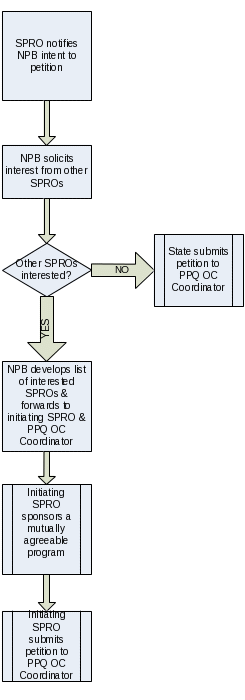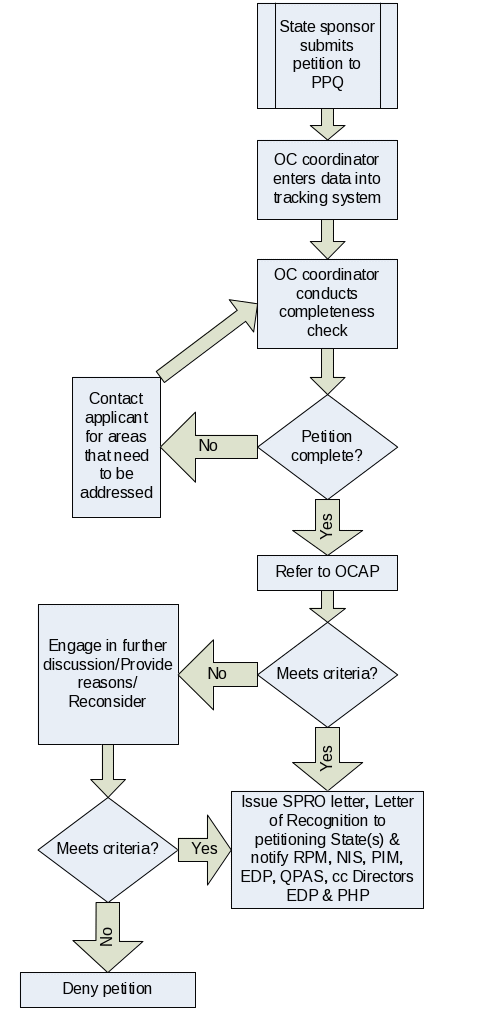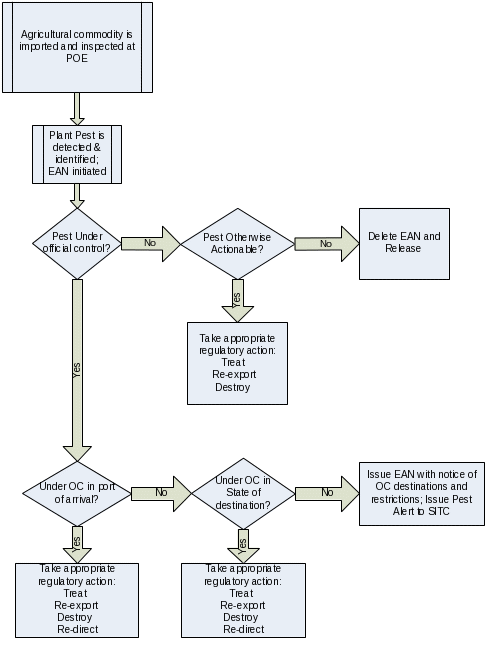Policy
20100304 OC Policy.doc
Plant Protection and Quarantine; Official Control Program
Policy
OMB: 0579-0365

Plant Protection and Quarantine’s (PPQ) Draft Policy for Recognizing State Managed Official Control Programs
PURPOSE:
The purpose of this document is to communicate the policy PPQ is drafting for the recognition of state managed official control programs provided for under Section 412 of the Plant Protection Act (PPA) (7 U.S.C. 7712) and in alignment with International Standard for Phytosanitary Measures (ISPM) No. 5, Supplement No. 1. The program is in the development process and PPQ will seek feedback as that process continues. This document has been reviewed and approved by the PPQ Executive Team.
The purpose of the PPQ Official Control Program (OC) is to provide recognition of state programs to eradicate or contain a plant pest that is not regulated by PPQ, and for equivalent protection to be provided at ports of entry for the same pest when destined to states where it is under official control. The International Plant Protection Convention (IPPC) includes provisions for the implementation of official control programs by sub-national authorities such as states, provided such programs are officially authorized and audited by the National Plant Protection Organization (NPPO). As the NPPO for the United States, PPQ has discretionary authority to authorize state managed official control programs under the Plant Protection Act of 2000 (PPA).
BACKGROUND:
Under Section 412 of the PPA, the Secretary of Agriculture may prohibit or restrict the importation, entry, exportation, or movement in interstate commerce of any plant, plant product, biological control organism, noxious weed, article, or means of conveyance, if the Secretary determines that the prohibition or restriction is necessary to prevent the introduction into the United States or the dissemination of a plant pest or noxious weed within the United States. The Secretary has delegated the authority for enforcing the PPA to the APHIS Administrator.
While the Secretary has the authority to regulate all plant pests, the Secretary has chosen to narrow the scope of the plant pests that we take action on at the U.S. ports of entry to be consistent with international obligations. As a contracting party to the IPPC, which is recognized in the World Trade Organization Agreement on the Application of Sanitary and Phytosanitary Measures as the standard-setting body for international plant quarantine issues, the United States has agreed to observe the general and specific principles of the convention as they relate to international trade. One such general principle provides that “countries shall institute restrictive measures only where such measures are made necessary by phytosanitary considerations, to prevent the introduction of quarantine pests.” Accordingly, there is an expectation on the part of other contracting parties to the IPPC (i.e., our trading partners) that APHIS would not exercise its authority under the PPA to prohibit or restrict the importation of a plant, plant product, or other article unless such action was necessary to prevent the introduction of a quarantine pest.
The IPPC’s “Glossary of Phytosanitary Terms” defines quarantine pest as “a pest of potential economic importance to the area endangered thereby and not yet present there, or present but not widely distributed and being official controlled.” A regulated non-quarantine pest is defined as á non-quarantine pest whose presence in plants for planting affects the intended use of those plants with an economically unacceptable impact and which is therefore regulated within the territory of the importing contracting party. While the first consideration (“a pest of economic importance…not yet present there”) may be readily understood, the concept of “official control” is subject to further definition. Specifically, the IPPC defines official control as “The active enforcement of mandatory phytosanitary regulations and the application of mandatory phytosanitary procedures with the objective of eradication or containment of quarantine pests or for the management of regulated non-quarantine pests.”
A State-managed Official Control Program addresses quarantine pests of limited distribution within the United States that are not being regulated under a Federal program or are being considered for deregulation, as well as regulated non-quarantine pests. Under this program, PPQ will be responsible for policies regarding port inspections that stop commodities infested with a particular pest destined for or moving through protected states. State partners are responsible for establishing eradication, control, or exclusion programs and petitioning for Federal recognition of those programs. The states will also address interstate movement and maintain monitoring and control programs for that pest. Phytosanitary requirements for interstate commerce will be equivalent to those expected from foreign trading partners.
POLICY:
To implement a Federal program for recognition of state managed official control, PPQ intends to accept petitions from interested states, review the petitions, and make decisions based on the established criteria and standards. PPQ will notify the states of PPQ’s decision. If PPQ federally recognizes the state’s program, PPQ will take action at the U. S. ports of entry for such pests destined to a state with a recognized official control program. PPQ will continue to take action on pests that are pending official control programs until such time that either 1) an official control program is established and recognized, 2) states have expressed no interest in a program, or 3) states are unable to establish a program that meets international requirements and PPQ cannot justify continued action.
The PPQ Executive Team expects that all PPQ programs that are affected by this policy will support the Official Control Program which will fulfill the Agency’s international obligations and provide support to our domestic partners.
DEFINITIONS
From ISPM No 5
Endangered Area – An area where ecological factors favor the establishment of a pest whose presence in the area will result in economically important loss
Monitoring - An official ongoing process to verify phytosanitary situations
Protected Area - A regulated area that an NPPO has determined to be the minimum area necessary for the effective protection of an endangered area
Quarantine Pest - A pest of potential economic importance to the area endangered thereby and not yet present there, or present but not widely distributed and being officially controlled
Regulated Non-Quarantine Pest - A non-quarantine pest whose presence in plants for planting affects the intended use of those plants with an economically unacceptable impact and which is therefore regulated within the territory of the importing contracting party
Survey - An official procedure conducted over a defined period of time to determine the characteristics of a pest population or to determine which species occur in an area
From Plant Protection Act of 2000
State- The term “state” means any of several states of the United States, the Commonwealth of the Northern Mariana Islands, the Commonwealth of Puerto Rico, the District of Columbia, Guam, the Virgin Islands of the United States, or any other territory or possession of the United States.
State Submits Petition for Federal Recognition of OC program.
The following information will be required in a Petition for Federal Recognition of an Official Control Program (see Figures 1 and 2):
Protocol for Quarantine Pests of Concern
1. Presence.
Provide evidence the pest does not exist in the state, or if it does exist, that it is being contained (by exclusion in some cases) or there are programs in place for eradication. Include appropriate survey data; define the infested area(s), endangered area(s), and protected area(s), and the procedures used for establishing containment (including exclusion) or eradication.
2. Possible entry and establishment.
Provide evidence that the pest could enter and become established in the state, or if it already exists in the state, that it could become widespread.
3. Economic/ environmental harm.
Provide evidence that the pest could cause economic and/or environmental harm in the state.
4. Maintenance/ Verification.
Provide a description of the state actions used to maintain and monitor for pest freedom, limit distribution, or containment (including exclusion) including a description of monitoring programs.
5. Quarantine regulations.
Provide a copy of the state, local or tribal quarantine regulations that provide for enforcement of the appropriate programs.
Protocol for Regulated Non-Quarantine Pests
1. Economic harm/ Vulnerability.
Provide evidence that a particular pest could cause significant harm to plants for planting if the pest was not managed through a certification program.
2. Quarantine regulations/ Testing.
Provide evidence the state has regulatory authority and a program established to manage the levels of the pest in plants for planting that are the hosts for the pest and a copy of the state, local or tribal quarantine regulations that provide for the enforcement of a management program, and testing protocols. Provide a description of recent state actions taken under these regulations and the testing protocols used in the program.
3. Management/ Verification.
Provide a description of state actions used to manage the level and/or verify producers’ management of pest in the plants for planting, where the pest is maintained below a level that can affect production, health, or marketability of plants for planting and cause an unacceptable economic impact to those plants.
Upon receipt of a petition from a state, the Official Control Program Coordinator will:
Track petition applications.
Verify Completeness of submission of information for a proposed Quarantine Pest.
Check the petition for:
Evidence the pest does not exist in the state, or if it does exist, it is being contained or eradicated
Evidence pest could enter and become established in the state, or if already present could become widespread
Evidence that the pest could cause economic and/or environmental harm in the state
Characteristics that may make the state vulnerable
State actions used to maintain pest freedom or limit distribution
Verification that pest freedom is maintained (if never present or eradicated)
State and local quarantine regulations that provide for enforcement of exclusion or control program
After reviewing the petition, the Official Control Coordinator will select one of the following:
Complete - proceed to next step
Incomplete - If the petition is incomplete, contact petitioner for areas that need to be addressed
Verify completeness of submission of information of a proposed Regulated Non-Quarantine Pest.
Check the petition for:
Evidence the pest could cause significant harm to plants for planting if not managed through a certification program
Evidence the state has regulatory authority and a program established to manage the levels of the pest in plants for planting that are hosts for the pest
State and local quarantine regulations that provide for enforcement of a management program and testing protocols, including recent state actions taken under these regulations and testing protocols used
State actions to manage the level and/or verify producers’ management of the pest in plants for planting where the pest is maintained below a level that can affect production, health or marketability of plants for planting and cause an unacceptable impact to those plants
After reviewing the petition, the Official Control Coordinator will select one of the following:
Complete - proceed to next step
Incomplete - If the petition is incomplete, contact petitioner for areas that need to be addressed
Official Control Advisory Panel (OCAP) Review Process (See Figure 3)
OC Program Coordinator will refer petitions to the OCAP.
Official Control evaluation criteria will guide the panel’s decision.
The criteria to be used by the OCAP in making its determination about whether to recommend approval or denial of the petition may include:
Pest risk argument that demonstrates that the pest does not occur in the proposed protected areas by citing sources such as supporting survey data
Pest risk argument that demonstrates that the pest is economically/environmentally significant and likely to establish in the proposed protected areas
Proposed measures that are the least restrictive needed to assure adequate protection
Domestic measures, including those administered by states, that are equivalent to international measures
Proposed measures apply only to shipments entering proposed protected areas
Protected area should not be highly susceptible to unimpeded natural spread of the pest
At a minimum, panel members should include the Official Control Program Coordinator and designees of the Emergency and Domestic Programs Associate Director, National Identification Services Staff member as primary Plant Health Programs representative, Center for Plant Health Science and Technology technical representative, Eastern and Western Regional Representatives.
Upon review, the OCAP will makeone of the following recommendations to the Executive Team:
Letter of Denial – if application is rejected after dialog to address any deficiencies
Letter of Acceptance
Upon petition acceptance and program implementation, the Official Control Coordinator will notify the following APHIS/PPQ staffs: Regulations, Permits & Manuals; National Identification Service; Phytosanitary Issues Management; Quarantine Policy & Analysis Staff; Emergency & Domestic Programs; cc: Executive Director Plant Health Programs; Assistant Deputy Administrator, Emergency and Domestic Programs.
The Official Control Coordinator will:
Issue final SPRO letter
Add program to Official Control website (to be established) and manual
National Identification Services will:
Update pest name, OC status (q-pest or RNQP) and regulated states
Approved programs will be subject to audit/monitoring requirements.
Program data will be entered into the appropriate database. State Departments of Agriculture will be required to submit annual reports.
Termination
States may notify the Official Control Coordinator of a decision to terminate an approved program.
After discussions with State Partners, APHIS PPQ may terminate a program for non-performance.
Process for States to Petition for Official Control

Figure 1
Alternate Process for a Petition when a Trade Issue Arises or to Resolve Pest Status Pending Official Control
Establish a list of regulated pests that may be considered for official control.
Categorize the plant pests on the list as:
Definite for consideration
Possible for consideration
Not likely to be considered
PPQ will resolve the list of pests pending official control. The pests of concern in international trade will take priority. Pests presented to the Official Control Coordinator by the New Pest Advisory Group (NPAG) will also receive high priority. Pests will be presented to the National Plant Board at the initial rate of 5-10 per quarter, with NPAG pests to be addressed as they are made available. Risk information will be included for each pest. If no SPRO is interested, the pest will be removed from the pending list and action will no longer be taken at ports of entry for that pest. If a SPRO or SPROs indicate interest in an official control program for a particular pest, then the US distribution will be shared so that appropriate regulations may be established. States will be given 60 days to consider a proposed candidate for official control. After 60 days, if no state expresses interest, PPQ will stop taking action on that pest at ports of entry.

Figure 2
Official Control Internal Process to Evaluate Petitions

Figure 3
Action to support Official Control at Ports of Entry: Emergency Action Notification - PPQ Form 523 (EAN) used for formal communication of remedial measures (See Figure 4)
When a pest is detected on an imported commodity, an Emergency Action Notification -PPQ Form 523 (EAN) is initiated by the PPQ Officer/Customs and Border Protection Agricultural Specialist.
If the identification of that pest reveals that it is under official control, the EAN will be used to communicate and document the required remedial measures, which are:
Treat
Re-export
Destroy
Redirect
If the commodity is not destined to or moving through a state where that pest is under official control, no regulatory action will be taken on the commodity, the EAN, however, will be issued as an official notice to the owner or his agent. PPQ identifiers or National Identification Services through PPQ identifiers will relate the official control action to the Customs and Border Protection Agriculture Specialist or PPQ Officer who is issuing the EAN. The EAN will communicate the remedial measures required should the commodity move to or through a state where the pest is under official control. Failure to comply with those requirements will be cause for a violation under Section 414 of the Plant Protection Act. The EAN will become a permanent attachment to the shipment’s paperwork, and responsibility for adherence to prescribed safeguards will transfer with ownership of the shipment. So should a future decision be made to move the shipment to a state with a state managed official control program for the pest present in the shipment, the shipment must meet official control requirements in order to be moved. The EAN will include directions to contact Quarantine Policy Analysis and Support (QPAS). In that event, QPAS will direct the owner to contact the appropriate State Plant Health Director to arrange for the required treatment.
When the EAN communicating required remedial measures is issued to an owner or agent whose commodity is not destined to a state under official control, PPQ will also issue a Pest Alert to the Smuggling Interdiction and Trade Compliance Team (SITC) for periodic quality assurance follow up in the market place. SITC may confirm by shipping records that the shipment did not move to that state. Pest Alert information may also be shared with the SPRO of program states under the terms of the general Memorandum of Understanding between PPQ and individual states. If records indicate that the shipment did indeed enter the state without remedial measures, a violation may be pursued.
Official Control Process at Port of Entry
Shipments
containing a pest under OC moving through a state with a program for
that pest will be required to provide adequate safeguards to meet
the requirements of the state.
Figure 4
Notice to Industry and Trading Partners
When the Official Control Program becomes operational, PPQ will submit a World Trade Organization Notice. New programs will be announced in a press release, which will also be listed on the APHIS home page “In the News” section. The PPQ Stakeholder Registry will provide communication of new programs to those subscribed as requesting notices of official control. A SPRO letter will be issued. The Official Control website will post all programs and related information to the public.
Inquiries
Inquiries should be directed to Diane Schuble (Diane.L.Schuble@aphis.usda.gov), National Coordinator for Official Control at (301) 734-8723.
| File Type | application/msword |
| Author | dschuble |
| Last Modified By | dschuble |
| File Modified | 2010-03-04 |
| File Created | 2010-03-04 |
© 2025 OMB.report | Privacy Policy